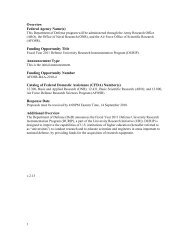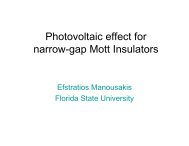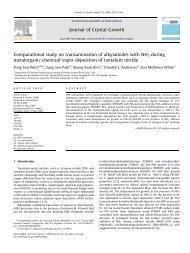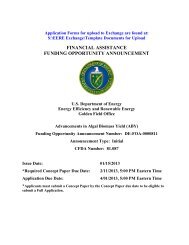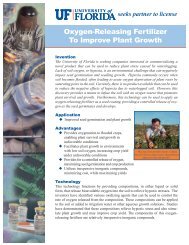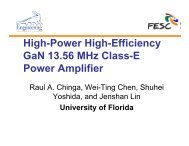Atomic layer deposition of GaN using GaCl3 and NH3
Atomic layer deposition of GaN using GaCl3 and NH3
Atomic layer deposition of GaN using GaCl3 and NH3
Create successful ePaper yourself
Turn your PDF publications into a flip-book with our unique Google optimized e-Paper software.
926 Kim, Kim, <strong>and</strong> Anderson: <strong>Atomic</strong> <strong>layer</strong> <strong>deposition</strong> <strong>of</strong> <strong>GaN</strong> <strong>using</strong> GaCl 3 <strong>and</strong> NH 3 926<br />
FIG. 5. Color online GIXD patterns for a ALD-<strong>GaN</strong> <strong>and</strong> b CVD-<strong>GaN</strong><br />
films grown on Si100 at 650 °C.<br />
dependency <strong>of</strong> film thickness on the number <strong>of</strong> cycles was<br />
then examined by XRR. The ALD growth conditions were<br />
7 s <strong>of</strong> GaCl 3 exposure time at 650 °C with the other steps at<br />
the base conditions, while the cycle number was varied in the<br />
range 5–200.<br />
The results are shown in Fig. 3 <strong>and</strong> indicate that the<br />
growth rate <strong>of</strong> ALD-<strong>GaN</strong> gradually increased toward a constant<br />
value <strong>of</strong> 2.1 Å/cycle below 15 cycles, <strong>and</strong> this transition<br />
period is termed the transient stage. The growth rate<br />
becomes constant 2.10.2 Å/cycle above 15 cycles, exhibiting<br />
a linear dependency <strong>of</strong> film thickness on the cycle<br />
number. This is expected to occur because the adsorption<br />
characteristics <strong>of</strong> GaCl 3 on bare Si or SiO x /Si are different<br />
than those on N terminated <strong>GaN</strong>. During the first few cycles,<br />
self-limiting adsorption likely does not occur. However, once<br />
the surface is fully covered <strong>and</strong> presumably a few <strong>layer</strong>s<br />
thick, relaxed <strong>GaN</strong> becomes the growth surface, which allows<br />
self-limiting adsorption.<br />
During the transient stage, it is possible that the adsorption<br />
<strong>of</strong> reactants <strong>and</strong> preferential growth on as-deposited film<br />
compete, leading to three dimensional 3D growth. For example,<br />
studies on ALD <strong>of</strong> high- materials have reported 3D<br />
growth during the transient stage. 14 To probe this possibility<br />
for ALD-<strong>GaN</strong>, AFM images <strong>of</strong> the surface <strong>of</strong> films deposited<br />
in the transient stage were taken. Figure 4 depicts the surface<br />
morphology <strong>of</strong> ALD-<strong>GaN</strong> films grown for 5, 10, <strong>and</strong><br />
FIG. 6.Color online Surface morphology <strong>of</strong> the 60-nm-thick <strong>GaN</strong> films<br />
deposited at 650 °C under a ALD growth condition <strong>and</strong> b CVD growth<br />
condition.<br />
15 cycles. Figures 4a <strong>and</strong> 4b show that the surface roughness,<br />
R q root-mean-square roughness is relatively high for<br />
films grown with 5 <strong>and</strong> 10 cycles R q =0.84 nm for 5 cycles,<br />
R q =0.72 nm for 10 cycles, consistent with the 3D growth.<br />
The surface <strong>of</strong> the sample grown for 15 cycles Fig. 4c,<br />
however, is substantially smoother R q =0.55 nm. Note that<br />
the linear region begins at 15 cycles <strong>and</strong> is considered the<br />
point at which complete coverage <strong>of</strong> <strong>GaN</strong> on Si substrate is<br />
obtained. This conclusion is supported by noting that the<br />
surface roughness <strong>of</strong> the sample grown for 150 cycles Fig.<br />
4d is close to that <strong>of</strong> 15 cycles R q =0.58 nm.<br />
D. Film microstructure<br />
Given the differences in reaction time <strong>and</strong> delivery sequence,<br />
differences in microstructure between ALD <strong>and</strong><br />
CVD films might be expected. To explore this possibility,<br />
GIXD patterns <strong>of</strong> <strong>GaN</strong> film deposited in ALD mode were<br />
compared to those deposited outside the ALD process window<br />
at higher <strong>deposition</strong> rate <strong>and</strong> those deposited in CVD<br />
mode. GIXD patterns for all ALD <strong>GaN</strong> films are presented in<br />
Fig. 5a that reveals the change in the crystalline orientation<br />
for two different GaCl 3 exposure times. The lower GIXD<br />
pattern in Fig. 5a shows the result for the film grown in<br />
J. Vac. Sci. Technol. A, Vol. 27, No. 4, Jul/Aug 2009





